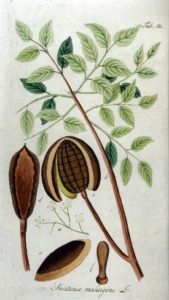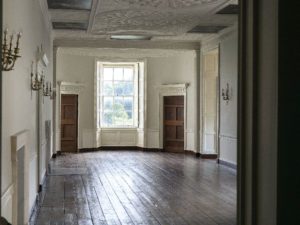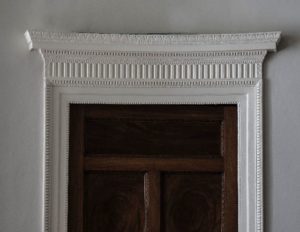Beauty arises from that species of elegance, which we call smoothness… The more the mahogany shines, the more it is considered as an object of beauty: as if the eye delighted in gliding smoothly over a surface… (Edmund Burke, A Philosophical Enquiry into the Origin of Our Ideas of the Sublime and Beautiful,1757)
Rathfarnham Castle is noted for its neoclassical interiors designed by William Chambers and James ‘Athenian’ Stuart, and its beautiful plaster and painted ceilings. Perhaps less remarked upon, but no less notable are the two curved mahogany doors in the Saloon. Often praised for their interesting shape, rich grain and colour, they are also a physical reminder of the enslavement of people halfway across the world.

Fig. 1 19th century illustration of Swietenia mahagoni
Rathfarnham Castle’s curved doors are made out of mahogany (Swietenia mahagoni). Regularly referred to as American, Cuban or West Indian mahogany, this wood is native to the Caribbean islands and southern Florida.[1] It was first imported by Europeans and North Americans in the late seventeenth century. However, initially it was used as ballast for shipments of logwood.[2] Mahogany was an understandable choice for ballast, as it grew in the same areas as logwood trees. From the 1720s cabinetmakers realised that this mahogany was excellent for woodworking and carving. By the 1750s dining tables, sideboards, tea tables, architectural woodwork and countertops were being made from mahogany. In its main markets in Europe and North America its popularity started to outstrip walnut and other woods.
Looking at the doors at Rathfarnham (Fig.2 ) you can understand why it was so popular. The timber has finely featured grains, deep colours and good density and weight. These doors most likely date to the 1770s, when Henry Loftus, Earl of Ely, set about renovating the Castle into a fashionable country villa. This was in the middle of the mahogany golden age which ran from 1725 to 1825. As we can see from Edmund Burke’s description of beauty, the smooth and polished nature of mahogany was at that time the very definition of beauty. For many, the smoothness and shine of mahogany furniture was seen as an embodiment of their polished manners, bolstering its popularity.


Initially, it was easy to provide the timber for this growing market. Large tracts of forests on the Caribbean islands were being clear cut in order to establish sugar plantations.[3] However, with so much demand and trees not being replaced, forests were quickly overexploited and the focus of mahogany harvesting moved to Central America. This mahogany, known as Honduran mahogany (Swietenia macrophylla) and exported from Belize, was of lower quality, lacking the same good properties of weight and density as mahogany from the Caribbean. Despite the fact that less and less good quality mahogany was available, or perhaps because of this situation, there was increasing demand for products made out of it. In 1765, an English mahogany dealer wrote to his supplier that mahogany had ‘become a mere Drugg all over the kingdom’.[4]
When we look at Rathfarnham Castle’s example of this highly prized commodity, we may think about the doors’ beauty, the cabinetmakers/carpenters’ craftsmanship that went in to making them, or perhaps the cost of acquiring them. However, less likely to come to mind are the people who harvested the timber in the Caribbean. The work of finding and extracting timber on Caribbean islands, including this type of mahogany, was done by indigenous peoples and enslaved Africans. It is hard to bring to mind the terrible treatment of these peoples when we look at an inanimate piece of wood. Yet we should be aware that much of the labour behind the most beautiful and sought after commodities was done by people who were enslaved, transported across the Atlantic like cargo in appalling conditions, and finally sold to an enslaver who they and their children had to work for until they died. Even when the trees were relatively easy to access, the work of harvesting these trees was back breaking. Later in the nineteenth century, animals were used to help transport the logs, but prior to this all the labour was done by humans. This involved dragging and rolling felled mahogany trunks to riverfronts and then floating the logs, which were chained together, to ships waiting in bays full of sharks and coral reefs. This is horrifying enough without thinking about how the enslaved were often branded, beaten and whipped.
While Burke was right about the beauty of mahogany, we should also keep in mind Charles Dickens’ reference to mahogany’s magnificent colour as ‘the hue of wretched slaves’. Hopefully by acknowledging all aspects of the history of these houses and objects, it will give us a fuller grasp and understanding of our history and its connections to events across the world.
[1] Swietenia mahagoni is in IUCN’s red list, with declining numbers.
[2] Logwood was an expensive dyestuff made from the heartwood of logwood trees (Haematoxylum campechianum).
[3] Despite the significant amounts of money could be made from mahogany; one mature tree could be worth upward of £1,000, the harvested trees were not replaced and the economy decided to focus on sugar, which was even more profitable.
[4] Jennifer L. Anderson, “Nature’s Currency: The Atlantic Mahogany Trade and the Commodification of Nature in the Eighteenth Century.” Early American Studies, vol. 2, no. 1, 2004, p. 65.
